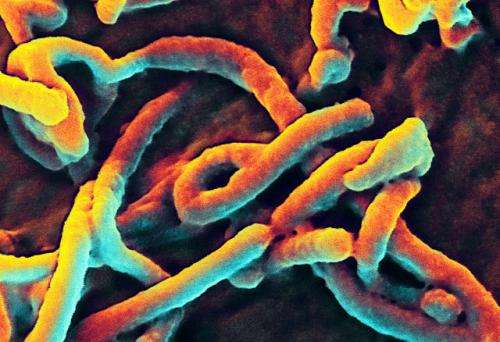Researcher says airborne Ebola transmission is not an impossibility

The idea of the Ebola virus becoming airborne is not far-fetched and its ability to enter cells that line the trachea and lungs has been shown under controlled laboratory conditions, a Purdue University virus expert says.
David Sanders, an associate professor of biological sciences who has studied the Zaire strain of Ebola virus that is responsible for the current outbreak in West Africa, says the possibility of the virus becoming airborne should not be discounted.
"It is not unprecedented for a virus to change its mode of transmission," he says. "Ebola does share some of the characteristics of airborne viruses like influenza, and we should not disregard the possibility of it evolving into something that could be transmitted in this way."
A research team led by Sanders and collaborators from the University of Iowa established that the Zaire strain of Ebola virus could enter the epithelial cells that line the human airway in a paper published in the Journal of Virology in 2003. The experiment used a pseudotyped virus, which was built with the Ebola virus envelope proteins, or outer shell. The inside of the virus was that of a retrovirus to prevent replication of the Ebola virus and to more easily separate the functions of the outer and inner portions of the virus, he said.
"We were studying at the cellular level how the virus enters cells and showed it could enter human airway epithelial cells," Sanders says. "However, there are many factors beyond its ability to enter these cells that influence how a virus is transmitted. To be airborne it must be present on tiny droplets from a cough or sneeze and must be able to live outside of the body for a certain length of time. This is not how the virus is currently known to spread, but it is evidence that it has some of the necessary components for respiratory transmission."
Sanders, who also has expertise in the transmission of viruses from animal to animal and animals to humans, also points to the influenza virus as an example of how a virus can switch from one mode of transmission to another. In birds, its natural host, influenza virus infects the intestinal tract and is transmitted by feces. In mammals, such as humans, it is transmitted. Only a small number of mutations are required to alter the host and mode of transmission, he says.
The death toll from the current Ebola outbreak continues to rise. More than 2,200 deaths have been attributed to the virus and there are 4,269 probable, confirmed and suspected cases in Guinea, Liberia and Sierra Leone, according to the World Health Organization.
It also appears the outbreak will continue for several more months, although the estimates vary. WHO estimates the outbreak will continue for nine months, while scientists modeling the epidemic for the federal government estimated it would last 12 to 18 months, the New York Times reported.
In past studies Sanders found that the entry of the Zaire strain of Ebola virus is most similar biochemically to the bird retroviruses, suggesting it may have at one time been associated with a bird host. His research also uncovered the first step in priming the virus for entry and has important implications for how the virus escapes the adaptive immune system and causes disease.
Studies in the Sanders laboratory also have provided a foundation for some of the current proposed treatments for Ebola virus and have implications for the effectiveness of others.
More information: "Lentivirus Vectors Pseudotyped with Filoviral Envelope Glycoproteins Transduce Airway Epithelia from the Apical Surface Independently of Folate Receptor Alpha" is available online: jvi.asm.org/content/77/10/5902.long


















